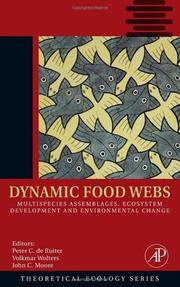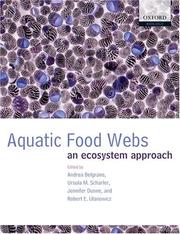| Listing 1 - 10 of 18 | << page >> |
Sort by
|

ISBN: 0199884919 1283113430 9786613113436 0199775052 0197700772 9780199775057 9781283113434 6613113433 0195188160 9780195188165 9780199884919 Year: 2006 Publisher: Oxford New York Oxford University Press
Abstract | Keywords | Export | Availability | Bookmark
 Loading...
Loading...Choose an application
- Reference Manager
- EndNote
- RefWorks (Direct export to RefWorks)
Food webs are one of the most useful, and challenging, objects of study in ecology. These networks of predator-prey interactions, conjured in Darwin's image of a "tangled bank," provide a paradigmatic example of complex adaptive systems. This book is based on a February 2004 Santa Fe Institute workshop. Its authors treat the ecology of predator-prey interactions, food web theory, structure and dynamics. The book explores the boundaries of what is known of the relationship between structure and dynamics in ecological networks and will define directions for future developments in this field.
Book
ISBN: 052131061X 9780521310611 9780511623431 9780521325479 Year: 1993 Publisher: Cambridge Cambridge University Press
Abstract | Keywords | Export | Availability | Bookmark
 Loading...
Loading...Choose an application
- Reference Manager
- EndNote
- RefWorks (Direct export to RefWorks)
Spiders --- Spider populations. --- Food chains (Ecology) --- Food chains (Ecology). --- Ecology.
Book
ISBN: 9780387886077 9780387893662 0387886079 Year: 2009 Publisher: New York Springer
Abstract | Keywords | Export | Availability | Bookmark
 Loading...
Loading...Choose an application
- Reference Manager
- EndNote
- RefWorks (Direct export to RefWorks)
Lipids in Aquatic Ecosystems provides a comprehensive summary of the most recent literature on the role of lipids in aquatic systems from many world experts. Essential fatty acids (EFAs), or omega-3 and omega-6 fatty acids as they are known in the popular press, have garnered considerable attention in the technical and popular literature during the last decade. Lipids are important energy storage molecules in most organisms. However, equally or even more important, specific lipids (e.g. EFAs) play critical roles in a wide range of physiological processes such as regulating the structural properties of cell membranes and serving as precursors to eicosanoid signaling molecules (i.e. prostaglandins, prostacyclins, the thromboxanes and the leukotrienes). It is well established the EFAs have important impacts on human health, and it is widely agreed that the classic "Western diet" is particularly imbalanced vis-à-vis foods containing omega-3 versus omega-6 fatty acids. But beyond the specialist literature, it is not widely known that the most physiologically important long chain, polyunsaturated omega-3 fatty acids, i.e. eicosapentaenoic acid (EPA) and docosahexaenoic acid (DHA) are produced de novo principally by aquatic algae. Furthermore, within aquatic ecosystems these molecules may be synthesized from precursor fatty acid molecules and/or concentrated as they are conveyed to animals consumed by humans. For example, in salmonid fish DHA and EPA constitute ~40% of total fatty acids, whereas in typical marine and freshwater phytoplankton EPA and DHA account for between 2% and 20% of total fatty acids. In humans, EPA and DHA play key roles in heart health, immune and inflammatory responses, visual acuity as well being major components of neurological tissues such as the brain and spinal cord. This realization has prompted great concern in the fisheries management community that the world's natural supply of EPA and DHA is being overexploited. There is also concern that global climate change and/or eutrophication processes may be modifying the production and availability of these molecules in aquatic ecosystems. Tremendous strides, as summarized in this book, have been made in our understanding of the specific enzymatic pathways by which various lipids are synthesized by producers and transformed by consumers within aquatic ecosystems. Recent research also indicates that in addition to EFAs, phyto-sterol lipids may play critical roles in the nutritional physiology aquatic fauna. This book also has state-of-the-art chapters on the utility of fatty acids are biomarkers of material and energy transfer in aquatic ecosystems. Primary producers at the base of aquatic food webs generally have distinctive fatty acid profiles and many studies have shown that these fatty acid "signatures" can be used as tracers of food web dynamics. Lipids also play important roles in the trophic transfer of a variety of lipid-soluble persistent organic pollutants, and selectively accumulate even with non-lipid soluble contaminants such as the powerful neurotoxin methyl mercury. Certain fatty acids may also serve as the substrates from which some toxins and allelopathic metabolites are produced. This book will be of interest to a wide range of scientists from the fields of marine and freshwater plankton ecology, algal physiology, fisheries management, nutritional science, food web ecology, aquaculture, toxicology, and environmental science. Michael T. Arts is a research scientist with Environment Canada at the National Water Research Institute in Burlington, Ontario, Canada. Michael T. Brett is a professor in the Department of Civil and Environmental Engineering at the University of Washington in Seattle. Martin J. Kainz is a research scientist at the WasserCluster - Biologische Station Lunz; an inter-university center dedicated to freshwater sciences research and education, in Lunz am See, Austria.
Aquatic ecology --- Lipids --- Food chains (Ecology) --- Aquatic ecology. --- Food chains (Ecology). --- Lipids.
Book
ISBN: 128357702X 9786613889478 0191646415 9780191646416 9781283577021 9780198566182 0198566182 9780198566199 0198566190 9780191774683 0191774685 0191646423 Year: 2012 Publisher: Oxford Oxford University Press
Abstract | Keywords | Export | Availability | Bookmark
 Loading...
Loading...Choose an application
- Reference Manager
- EndNote
- RefWorks (Direct export to RefWorks)
This novel book bridges the gap between the energetic and species approaches to studying food webs, addressing many important topics in ecology. Species, matter, and energy are common features of all ecological systems. Through the lens of complex adaptive systems thinking, the authors explore how the inextricable relationship between species, matter, and energy can explain how systems are structured and how they persist in real and model systems. Food webs are viewed as open anddynamic systems. The central theme of the book is that the basis of ecosystem persistence and stability rests on the
Coral reef ecology. --- Food chains (Ecology). --- Science -- Experiments. --- Science -- Study and teaching. --- General ecology and biosociology --- Food chains (Ecology) --- Ecology.
Book
ISBN: 0387511296 3540511296 3642837867 3642837840 9780387511290 9783642837869 Year: 1990 Volume: 20 Publisher: Berlin : Springer,
Abstract | Keywords | Export | Availability | Bookmark
 Loading...
Loading...Choose an application
- Reference Manager
- EndNote
- RefWorks (Direct export to RefWorks)
Food chains (Ecology) --- Mathematical models --- Ecology --- Food supply --- Mathematics. --- Models --- Mathematical models. --- theoretical --- Issue --- Ecology. --- Food supply. --- theoretical. --- Theoretical. --- Food chains (Ecology) - Mathematical models
Book
ISBN: 9781107077324 9781107434325 9781139924856 Year: 2015 Publisher: Cambridge Cambridge University Press
Abstract | Keywords | Export | Availability | Bookmark
 Loading...
Loading...Choose an application
- Reference Manager
- EndNote
- RefWorks (Direct export to RefWorks)
As researchers try to predict the effects of human modification at all trophic levels and mediate the impact of rapid environmental change, it has become clear it is no longer a matter of agreeing that both bottom-up and top-down forces play important roles in diverse ecosystems. Rather, the question is: how do these forces interact across aquatic and terrestrial systems? Written by leading experts in the field, this book presents a unique synthesis of trophic relationships within and across ecosystems that is a valuable foundation for the development of cross-system, multidisciplinary research. It also provides new insights into population biology and community ecology and examines the interactive effects of bottom-up and top-down forces on biodiversity at each trophic level. A one-stop resource for learning about bottom-up and top-down interactions, this book encourages discussion and collaboration among researchers to identify similarities and differences in trophic interactions across aquatic and terrestrial systems.

ISBN: 0120884585 9780120884582 9786610633265 1280633263 0080460941 9780080460949 9781280633263 6610633266 Year: 2005 Publisher: Amsterdam Boston Academic Press
Abstract | Keywords | Export | Availability | Bookmark
 Loading...
Loading...Choose an application
- Reference Manager
- EndNote
- RefWorks (Direct export to RefWorks)
Dynamic Food Webs challenges us to rethink what factors may determine ecological and evolutionary pathways of food web development. It touches upon the intriguing idea that trophic interactions drive patterns and dynamics at different levels of biological organization: dynamics in species composition, dynamics in population life-history parameters and abundances, and dynamics in individual growth, size and behavior. These dynamics are shown to be strongly interrelated governing food web structure and stability and the role of populations and communities play in ecosystem functioning.
Animal population --- plant population --- population dynamics --- Food chains --- Models --- Biodiversity --- ecosystems --- Biological competition --- Food chains (Ecology). --- Food chains (Ecology) --- Food webs (Ecology) --- Trophic ecology --- Animals --- Ecology --- Nutrient cycles --- Food

ISBN: 1281190411 0191524069 9786611190415 019856483X 1435620844 9780191524066 9780198564829 0198564821 9780198564836 9780191713828 0191713821 9781435620841 0198564821 Year: 2005 Publisher: Oxford Oxford University Press
Abstract | Keywords | Export | Availability | Bookmark
 Loading...
Loading...Choose an application
- Reference Manager
- EndNote
- RefWorks (Direct export to RefWorks)
'Aquatic Food Webs' provides a current synthesis of theoretical and empirical food web research. The textbook is suitable for graduate level students as well as professional researchers in community, ecosystem, and theoretical ecology, in aquatic ecology, and in conservation biology.
Aquatic ecology. --- Food chains (Ecology) --- Food webs (Ecology) --- Trophic ecology --- Animals --- Ecology --- Nutrient cycles --- Aquatic biology --- Food --- Aquatic ecology

ISBN: 0521791103 9780521791106 0511067194 9780511067198 0511069324 9780511069321 0511170521 9780511170522 1280418176 9781280418174 9780511542190 0511542194 9780521084185 0521084180 1107129672 9786610418176 1139146793 0511060882 0511297580 Year: 2002 Publisher: Cambridge, U.K. New York Cambridge University Press
Abstract | Keywords | Export | Availability | Bookmark
 Loading...
Loading...Choose an application
- Reference Manager
- EndNote
- RefWorks (Direct export to RefWorks)
The multitrophic level approach to ecology addresses the complexity of food webs much more realistically than the traditional focus on simple systems and interactions. Only in the last few decades have ecologists become interested in the nature of more complex systems including tritrophic interactions between plants, herbivores and natural enemies. Plants may directly influence the behaviour of their herbivores' natural enemies, ecological interactions between two species are often indirectly mediated by a third species, landscape structure directly affects local tritrophic interactions and below-ground food webs are vital to above-ground organisms. The relative importance of top-down effects (control by predators) and bottom-up effects (control by resources) must also be determined. These interactions are explored in this exciting volume by expert researchers from a variety of ecological fields. This book provides a much-needed synthesis of multitrophic level interactions and serves as a guide for future research for ecologists of all descriptions.
Multitrophic interactions (Ecology). --- Environmental Sciences and Forestry. Environmental Management --- Environmental Protection. --- ecosystems --- Animal population --- plant population --- Biological competition --- Multitrophic interactions (Ecology) --- Interactions, Multitrophic (Ecology) --- Food chains (Ecology)
Book
ISBN: 9781620810538 1620810530 9781613243770 1613243774 Year: 2012 Publisher: New York
Abstract | Keywords | Export | Availability | Bookmark
 Loading...
Loading...Choose an application
- Reference Manager
- EndNote
- RefWorks (Direct export to RefWorks)
Environmental toxicology. --- Food chains (Ecology) --- Food webs (Ecology) --- Trophic ecology --- Animals --- Ecology --- Nutrient cycles --- Ecotoxicology --- Pollutants --- Pollution --- Environmental health --- Toxicology --- Food
| Listing 1 - 10 of 18 | << page >> |
Sort by
|

 Search
Search Feedback
Feedback About UniCat
About UniCat  Help
Help News
News